Come for the World Cup, stay for the culture: an insider’s guide to Ahmedabad
The ICC Men’s Cricket World Cup 2023 has led to a massive surge in sports-led tourism in Ahmedabad. But there’s a lot more you can do in India’s first UNESCO World Heritage City.
There is one constant in a military family’s life: change.
As children, my sister and I were accustomed to moving every two years. We said goodbye to friends, schools, homes, and all that was familiar, only to say hello to newness and the unfamiliar–like clockwork.
We were often told that we lacked roots, but we were happy with our wings. The one time, the only time, we grew roots–vines actually–was after my father retired and we settled in Ahmedabad.
Home, which had till then been where the family was, became specific and defined. Ahmedabad was home, home was Ahmedabad.
Ahead of the ICC Men’s Cricket World Cup 2023, my home town has seen a massive surge in sports-led tourism. The Narendra Modi Stadium, which hosted the opener between England and New Zealand, will host three other marquee games–the much-anticipated match between bitter rivals India and Pakistan (October 14), England versus Australia (October 28), and South Africa versus Afghanistan (November 10)–as well as the World Cup final.
Online travel agency Agoda has reported a 1,702% rise in people looking for hotels in Ahmedabad around the match dates.
But what do you do once the last ball has been bowled and a winner has been declared? After spending years exploring Ahmedabad, I suggest you stay back to explore the culture.
Spread out on both banks of the Sabarmati, the commercial capital of Gujarat was founded in the year 1411 by Sultan Ahmed Shah. The city was the capital of Gujarat for six centuries, until Gandhinagar took over in 1970.
Apart from being an important economic and industrial hub, Ahmedabad also offers an amalgam of architecture, culture, food, and more. A variety of museums and a bustling fine dining and street food scene mean your to-do list will never run out. No wonder that India's first UNESCO Urban World Heritage Site was included by Time magazine in its list of the world's 50 greatest places of 2022.
When in Ahmedabad for cricket, YS Life suggests you make time for these can’t-be-missed experiences.
Take a leisurely heritage walk in the old city
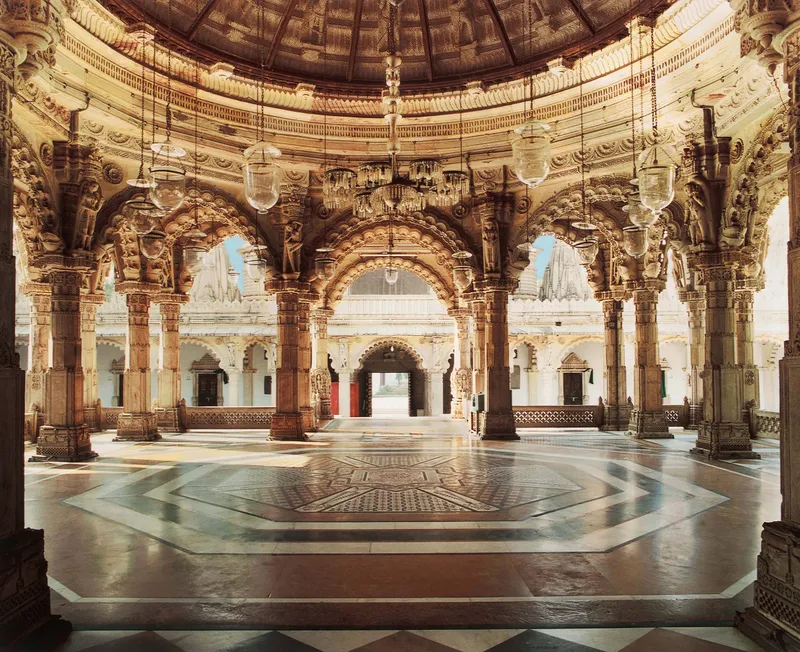
The Hutheesing Jain temple is crafted out of white marble and showcases 12 ornate pillars and a medley of motifs | Image Courtesy: Umang Hutheesing
Ahmedabad’s architecture is said to have inspired a young Shah Jahan, the Mughal emperor who went on to build the Taj Mahal in Agra in memory of his beloved queen.
The cityscape now sees the co-existence of ancient mosques and mausoleums, traditional residential clusters and narrow streets, and buildings by famed architects such as Le Corbusier, Louis Kahn, and BV Doshi.
In 2017, the 600-year-old walled city of Ahmedabad was recognised as a UNESCO World Heritage City, the first Indian city to be chosen. The best way to explore this is by walking through the old city amid the many havelis, pols, and khadkis.
The Ahmedabad Municipal Corporation organises three heritage walks: a morning walk, an evening walk, and a Jain Amdavad Walk. Priced Rs 400 upwards and spread out over a leisurely 2.5 hours, the first two take you through the major attractions: Swaminarayan Temple, Kavi Dalpatram Chowk, Calico Dome, Kala Ramji Mandir, Manek Chowk, Rani no Haziro, Badshah no Haziro, Jama Masjid, and Muhurat Pol. The Jain version takes you on a walking tour of the Jain derasars (temples).
You can also sign up for the House of MG guided breakfast or night walk through the top highlights. End with an Indian breakfast when you return to the House of MG or stop off for a late-night snack at Manek Chowk.
Fun fact: Vegetable market by day, jewellery market by afternoon, Manek Chowk morphs into a food lane by night. Don't miss the kulfi and gola!
Find peace at Sarkhej Roza, Ahmedabad’s Acropolis
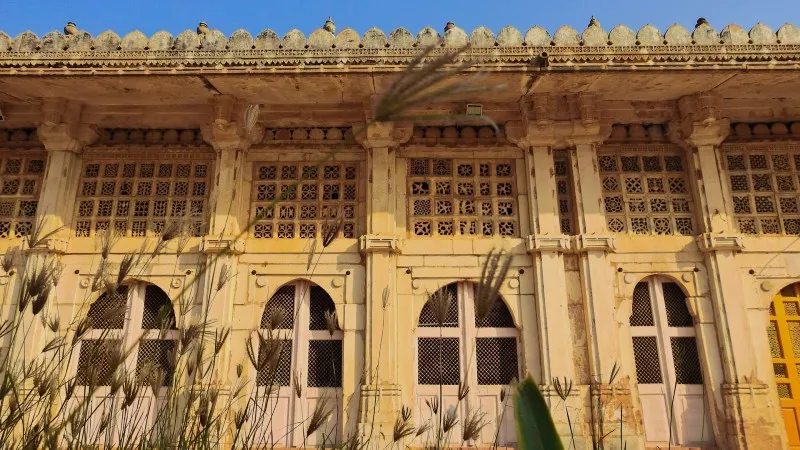
The intricate lattice work makes Sarkhej Roza sheer “poetry in stone”–especially at sunrise and sunset | Image source: Wikimedia Commons
This elegant architectural complex, located in Makarba, a village about 7 km from Ahmedabad, was famously dubbed “Ahmedabad’s Acropolis” by famed architect Le Corbusier. In a city that’s now bursting at the seams, this mosque and tomb complex allows moments of quietude amid its worn magnificence.
Sarkhej, home to influential Sufi saint Shaikh Ahmed Ganj Baksh, was once a prominent centre of Sufi culture. Sultan Ahmad Shah set up his capital on the banks of the Sabarmati on the saint’s suggestion. When he died in 1445, the sultan ordered the construction of a mausoleum and a mosque in his memory. The complex was expanded by the next sultan, Mahmud Begada, who added palaces and pavilions, and his own tomb.
Spread over 72 acres, the structure is built around a stepped tank, surrounded by a large, 120-pillared mosque, the saint’s tomb, the tombs of the sultan and his family, a palace, and a pavilions. The buildings, built in locally quarried stone, exemplify the Indo-Saracenic style: Islamic features like pillars, brackets, and ringed domes come together with Hindu elements like ornamentation and motifs. The intricate lattice work makes Sarkhej Roza sheer “poetry in stone”–especially at sunrise and sunset.
Fun fact: A few scenes of Shah Rukh Khan's Raees were shot at Sarkhej Roza.
Explore the city's African connection at Sidi Saiyyed Mosque
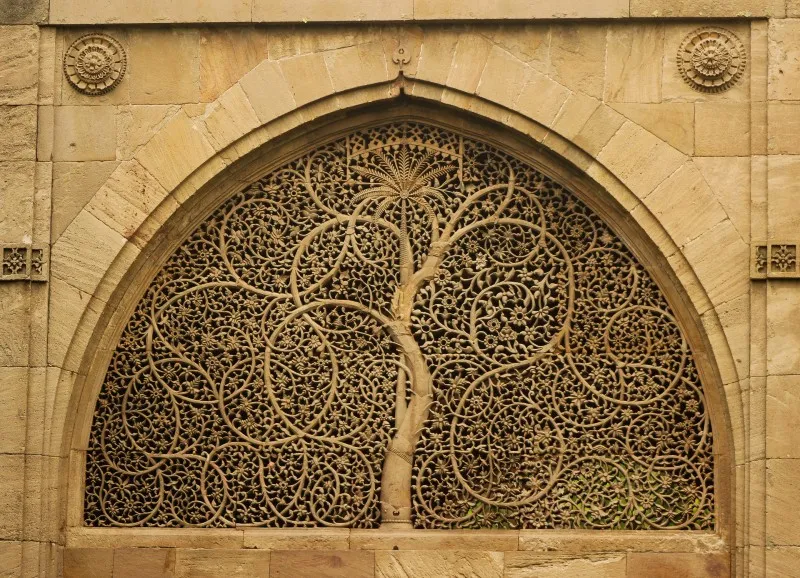
The jali at Siddi Saiyyed Mosque, with carvings that represent the Tree of Life, is one of the finest examples of stone lattice work| Image source: Wikimedia Commons
The Sidi Saiyyed Mosque, built in the 16th century, is locally known as Sidi Saiyyed ni Jali on account of its most famous feature: an intricately carved window showcasing the Tree of Life.
Located in the heart of the walled city, the mosque was commissioned in 1573 by a leader of the Sidis, descendants of East Africans brought to India by Arab, Portuguese, and British slave traders. The arcuate design showcases arches, domes, squinches, and vaults, and showcases the African architectural legacy in India.
Today, the mosque may have been reduced to a traffic island of sorts, but it remains renowned for its 10 intricately carved stone lattice work windows (jalis) on the side and rear arches. Vincent Arthur Smith, a 20th-century Indologist and art historian, described these jalis as the “most artistic stone lattice work to be found anywhere in the world.”
The most impressive is the 16-feet jali located to the right of the central walled arch, with carvings that represent the Tree of Life motif, an artistic representation of a tree believed to grow in paradise according to Islamic mythology. Stop by at dawn or dusk to enjoy the filigree-like work and enjoy the natural light and shadow show.
Fun fact: The Sidi Saiyyed Jali was the inspiration for the design of the logo of IIM Ahmedabad.
Learn about the tragic backstory of Adalaj ni Vav
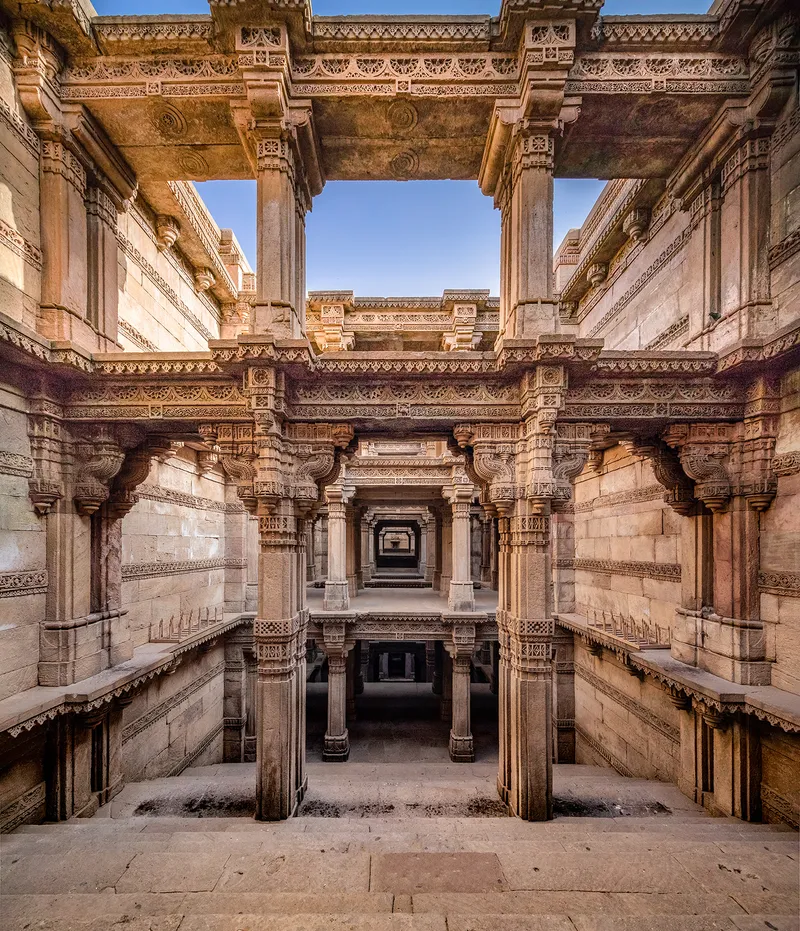
One of the finest stepwells in Gujarat, the five-storied Adalaj ni Vav melds elements of Hindu and Islamic architecture | Image source: Wikimedia Commons
Located in the small town of Adalaj, about 19 km from Ahmedabad, this beautiful 15th-century stepwell runs five storeys deep. The entire structure is rich in carvings, sculptures, and ornamentation–a marriage of Islamic floral patterns and Hindu and Jain symbolism.
Stepwells are common in western India. In Gujarat, where they are called vav, there are more than a hundred.
The Adalaj architectural wonder has a tragic backstory: it was commissioned by Rana Veer Singh to provide relief–and water-to his subjects. But he died in a war with Mehmud Begada, who fell in love with his widow. Queen Rudabai agreed to marry Begada if he finished the stepwell–the reason why the Solanki style of architecture shows Islamic influences. However, the queen had no intention of marriage; she jumped into the stepwell after it was completed.
Adalaj ni Vav has three sets of entrance stairs, which converge on the first level at a large square platform. The opening in the ceilings above the landing lets light and air enter the octagonal well. However, direct sunlight never touches the steps except at noon. No wonder then that the air grows noticeably cooler the further underground one goes! The walls are covered in ornamental carvings, including motifs like ami khumbor (a pot containing the water of life) and the Kalp Vruksha (the tree of life).
Fun fact: Like most stepwells in India, the levels of the structure were made large enough so people could congregate, socialise, and relax.
Walk in Mahatma Gandhi’s footsteps

Shaped like a colossal mound of salt, Dandi Kutir showcases how Mahatma Gandhi brought people across lines of class, gender, age, and community together to assert their common right to salt | Image Courtesy: Gujarat Tourism
Gujarat, the birthplace of Mahatma Gandhi, is synonymous with the many satyagrahas launched by the Father of the Nation to help India achieve Independence. It is where he grew up, returned from South Africa to set up his ashram, and from where he targeted the British with numerous acts of non-violent civil disobedience.
The Gandhi Ashram, located on the banks of the Sabarmati, was home to Gandhi from 1917 to 1930, and one of the key places from where the struggle for Indian Independence started. This is the place from where the Dandi March was flagged off. Explore the two sections: Hriday Kunj, the cottage where the Mahatma lived, and the Charles Correa-designed museum that has three galleries, the Gandhi in Ahmedabad Gallery, the Painting Gallery, the My Life is My Message Gallery, and a library.
In Gandhinagar, about 28 km from Ahmedabad, visit Dandi Kutir, India’s largest and only museum built on the life and teachings of Mahatma Gandhi. The audio-visual exhibition traces his journey—from birth and childhood to marriage, youthful experiments, and the freedom struggle.
Shaped like a colossal mound of salt, the museum showcases how Gandhi brought people across lines of class, gender, age, and community together to assert their common right to salt.
Fun fact: Pick a postcard and mail at the in-house post box. It will be sent out with a special charkha stamp!
Eat your way through a Gujarati thali at Agashiye
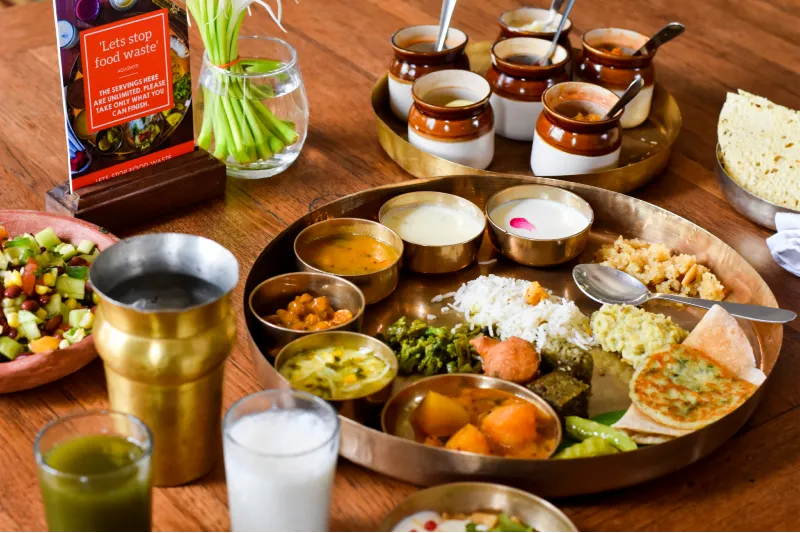
The traditional way to end a Gujarati thali is with a glass of spiced buttermilk, followed by a well-deserved nap! | Image source: House of MG
The word agashiye in Gujarati means “on the terrace”. Spread over the huge terrace of The House of MG, a 38-room boutique hotel housed in a building showcasing early 20th century colonial architecture, Agashiye is famed for its thali.
The idea behind a thali meal is simple: it should amalgamate all the six different flavours–sweet, salt, sour, astringent, spicy, and bitter–and provide a balanced meal. The Gujarati thali offers an astonishing variety–between 12-18 dishes come together and ultimately leave you moaning about overeating!
Ahmedabad has dozens of thali restaurants, but Agashiye stands apart. The lip-smacking meal is served in silver and kansa thalis. Begin with a sharbat, followed by farsan (snacks) and chutney, and move on to the shaak (vegetables), kathol (lentils), dal, kadhi, rotli, bhakri, pickles, chutney, and papad. Rice and khichdi are on the menu as well. The sweet offerings–aamras, mohanthal, basundi, jalebi, and ice cream–can’t be ignored. The traditional way to end a thali is with a glass of chaas (spiced buttermilk)–and then go home for a well-deserved nap!
The award-winning restaurant's thali may be at the upper end of the price spectrum (Rs 1,200+), but the experience is unparalleled. So, when in Gujarat, eat like a Gujarati!
Fun fact: PM Narendra Modi once hosted his Japanese counterpart for a sit down spread with more than 30 items.
Edited by Megha Reddy







